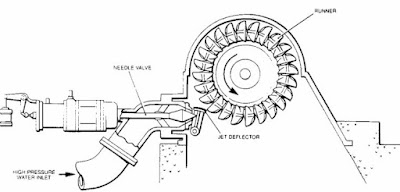The Pelton turbine is a hydraulic turbine used for the generation of AC current electricity at hydroelectric power station at dams. Designed by the American engineer Lester A. Pelton in the 1870s, it uses the kinetic energy of a powerful stream of water. It is composed of a high-pressure water inlet, the nozzle with the needle valve, and a series of buckets attached to the rim of a wheel; these are called runner. The water jet pushes the buckets, making the wheel rotate. The number of buckets on the rim of the wheel ranges from 18 to 25.
The Pelton turbine is used in applications where there is a relatively small rate of flow at a large head, greater than 300 m. The whole of the pressure head is converted to velocity in one or more nozzles in parallel when it impinges on the buckets. Each buckets, in turn, consists of a pair spoon-shaped lobes. The central ridge that divides them split the water jet, guiding each of the two flows through an angle of about 165°.
The fast-running water is directed into the buckets by means of a nozzle. This flow of water as well as the output is controlled by a central needle, or spear, whose bulbed head varies the flow areas as it moves axially within the nozzle. A quick shut-down of the turbine cannot be done by rapid closure of the needle because of the water hammer effects. Thus, shut-down is done by inserting a deflector to direct the jet of water away from the bucket.
Below, diagram of a Pelton turbine



